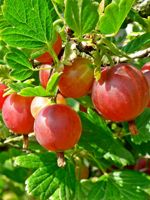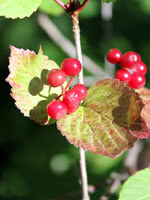Mon-Fri 9am - 5pm Mountain time
Lowbush Cranberry vs Sebastien Gooseberry
Ribes uva-crispa Sebastien
Viburnum edule
NOT AVAILABLE THIS SEASON - MIGHT RETURN
(new stock expected: fall of 2026)
NOT AVAILABLE THIS SEASON - MIGHT RETURN
Sebastien Gooseberry is a nearly thornless variety that produces medium-sized, red gooseberries. When the berries are fully ripe they are quite sweet and great for fresh eating. They can be stored for up to two weeks in the fridge. For baking and preserves, they are often picked when under-ripe when they are firm and tart. The general harvest period is anywhere from July to September.
Sebastien Gooseberry is a Canadian variety that was developed at the Agriculture and Agri-Food Canada research station in Ottawa.
Gooseberries are self-pollinating but planting with another variety will increase yields.
Lowbush Cranberry is a short, deciduous shrub native to North America. Its white flowers bear sour but edible fruit that ripens to a brilliant red in fall. Lowbush Cranberry's small size makes it suitable for urban use; buyers will also find it useful if trying to reclaim land back to its original species or when landscaping with native species in damp conditions.
Sebastien Gooseberry Quick Facts
Lowbush Cranberry Quick Facts
Toxicity: leaves are toxic to humans

